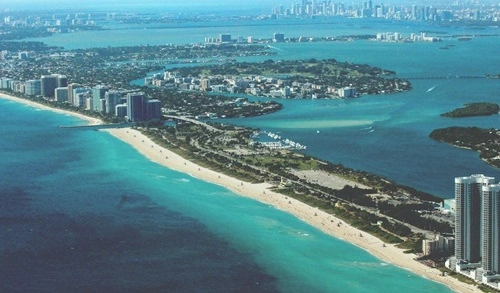Florida, known as the Sunshine State, is one of the most popular destinations in the United States for those seeking warm weather, beautiful beaches, and a laid-back lifestyle. With a mix of bustling cities, charming small towns, and a vibrant cultural scene, Florida offers something for everyone. However, as with any location, living in Florida comes with its own set of advantages and challenges.
This article explores the pros and cons of living in Florida, helping you make an informed decision about whether it’s the right place for you.
The Pros of Living in Florida

1. Warm Weather Year-Round
Florida’s tropical and subtropical climate provides sunshine and warmth throughout the year. Winters are mild, with temperatures rarely dipping below 50°F, making it an ideal place for those who dislike cold weather.
2. No State Income Tax
One of Florida’s biggest financial perks is the absence of a state income tax. Residents keep more of their earnings, which can be a significant draw for retirees, entrepreneurs, and high-income individuals.
3. Beautiful Beaches
With over 1,300 miles of coastline, Florida is home to some of the world’s most beautiful beaches. Destinations like Miami Beach, Clearwater, and the Florida Keys offer pristine sand, crystal-clear waters, and a wide range of recreational activities.
4. Outdoor Activities
Florida’s natural beauty provides endless opportunities for outdoor enthusiasts. From fishing and boating to hiking and kayaking, the state offers activities to suit every lifestyle. The Everglades National Park and numerous state parks add to the outdoor appeal.
5. Tourist Attractions
Florida boasts world-famous attractions, including Walt Disney World, Universal Studios, and Busch Gardens. Residents often enjoy discounts to these destinations, adding to the state’s entertainment value.
6. Cultural Diversity
As a melting pot of cultures, Florida is home to a rich tapestry of traditions, cuisines, and festivals. Cities like Miami and Orlando reflect a vibrant mix of Hispanic, Caribbean, and global influences.
7. Affordable Housing (in Some Areas)
Compared to other states with warm climates, such as California or Hawaii, Florida offers more affordable housing options. While prices have risen in recent years, many areas remain within reach for middle-income families.
8. Booming Job Market
Florida’s economy is diverse, with strong industries in tourism, healthcare, aerospace, agriculture, and technology. Major cities like Miami, Tampa, and Jacksonville provide ample job opportunities.
9. Retirement-Friendly
Florida is one of the top destinations for retirees, thanks to its warm climate, tax benefits, and numerous retirement communities. Seniors can enjoy an active lifestyle with plenty of recreational and social opportunities.
10. Sports and Entertainment
Florida is a haven for sports fans, hosting teams from the NFL, NBA, MLB, NHL, and MLS. The state is also home to major events like the Daytona 500, PGA golf tournaments, and college football championships.
The Cons of Living in Florida
1. Hurricanes and Severe Weather
Florida’s location makes it highly susceptible to hurricanes, tropical storms, and flooding. Residents need to prepare for hurricane season, which runs from June to November, and invest in stormproofing their homes.
2. High Humidity
While the warm weather is a plus, Florida’s humidity can be uncomfortable, especially during the summer months. The combination of heat and humidity often results in sticky, sweltering conditions.
3. Tourist Crowds
As a top tourist destination, Florida attracts millions of visitors annually. This can lead to crowded beaches, congested roads, and long waits at popular attractions, particularly during peak tourist seasons.
4. Cost of Homeowners Insurance
Due to the risk of hurricanes and floods, homeowners insurance in Florida is significantly higher than the national average. This added expense can be a financial burden for property owners.
5. Pest Issues
Florida’s warm, humid climate is ideal for insects and pests. Residents often deal with mosquitoes, ants, termites, and even larger creatures like alligators, particularly in rural or suburban areas.
6. Urban Sprawl and Traffic
Florida’s rapid population growth has led to urban sprawl and increased traffic congestion, particularly in cities like Miami, Orlando, and Tampa. Commuters may face long travel times, especially during rush hours.
7. Seasonal Population Swings
Florida experiences an influx of seasonal residents, known as “snowbirds,” during the winter months. While this boosts the economy, it can lead to overcrowding in some areas, impacting local infrastructure and resources.
8. Lack of Public Transportation
Most Florida cities are car-dependent, with limited public transportation options. While larger cities like Miami and Orlando have some transit systems, they are not as extensive or efficient as those in other major metropolitan areas.
9. Rising Cost of Living
While some parts of Florida remain affordable, others, particularly coastal cities, have seen a rise in the cost of living. Housing, utilities, and healthcare expenses can vary significantly depending on the region.
10. Educational Challenges
Florida’s public education system has faced criticism for funding disparities and performance issues in some districts. Families with school-aged children should research local school options carefully.
Who Should Consider Living in Florida?
Florida is an excellent choice for:
- Retirees: Warm weather, tax benefits, and vibrant communities make it ideal for retirees.
- Beach Lovers: Access to beautiful beaches and water activities is a major draw.
- Professionals: Growing industries and job opportunities attract young professionals.
- Families: Family-friendly attractions and suburban areas appeal to those with children.
However, Florida may not be ideal for:
- Those Sensitive to Heat: The intense heat and humidity can be challenging for some.
- People Averse to Crowds: Tourists and seasonal residents may cause frustration in popular areas.
- Individuals Seeking Mountainous Landscapes: Florida’s flat terrain lacks the variety found in other states.
Tips for Living in Florida
- Prepare for Hurricanes: Invest in hurricane shutters, flood insurance, and an emergency plan to stay safe during storm season.
- Choose the Right Location: Florida’s regions vary widely in terms of lifestyle, climate, and cost. Research cities and neighborhoods that align with your needs.
- Stay Cool: Use energy-efficient air conditioning and stay hydrated to combat heat and humidity.
- Plan Around Traffic: Consider commute times and road congestion when choosing a place to live.
- Enjoy Outdoor Living: Take advantage of Florida’s natural beauty, beaches, and parks to make the most of its sunny climate.
Conclusion
Florida offers a unique lifestyle that combines warm weather, stunning beaches, and a diverse cultural scene. Its financial perks, recreational opportunities, and job market make it an attractive option for many. However, challenges such as hurricanes, high humidity, and crowded tourist areas require careful consideration.
By weighing the pros and cons of living in Florida, you can determine whether it’s the right fit for your lifestyle and goals. For those who embrace its sunny climate and vibrant atmosphere, Florida provides a welcoming and dynamic place to call home. Whether you’re drawn by its beaches, tax benefits, or cultural diversity, the Sunshine State has something for everyone.



